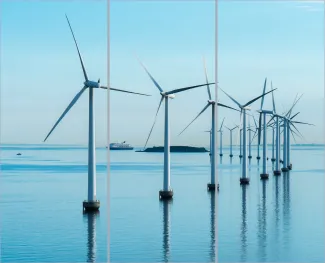
For those tracking progress in the clean energy sector, a few headlines may have piqued your interest over recent days. The UN General Assembly declared 26 January 2024 as the International Day of Clean Energy. This date was a particularly memorable one for Scotland, as it was announced that renewables produced more than 100% of Scotland’s electricity for the first time (data from the Scottish Government indicated that in 2022, 113% of Scotland’s gross electricity consumption was generated from renewables).
One might conclude that we are doing well in the fight to tackle global warming, but less than 48 hours later we were met with an altogether different headline: A new UK record high temperature was set in the Scottish Highlands, with a peak of 19.6C (67.3F) at Kinlochewe on Sunday, January 28. If the provisional figures from the Met Office are confirmed, this would be the highest UK temperature for January and remarkably, the highest temperature in winter for Scotland, ever. With this headline following mere days after Storms Isha and Jocelyn along with confirmation that 2023 was the warmest year on record, we are now regularly witnessing the frightening extremes of climate change.
Offshore wind is the technology that is going to help the UK reach the net zero target faster than all others - the scale is vast, and the technology has matured in short order. It is a remarkable success story which can also help fulfil our security of supply needs. The UK government agrees and the April 2022 British Energy Security Strategy set an ambition to deploy up to 50 gigawatts of offshore wind capacity in the UK by 2030, with up to five gigawatts from floating wind. The ScotWind leasing rounds granted by Crown Estate Scotland in 2022 support this ambition – 20 offshore wind projects, with a combined 27.6GW of capacity were awarded and the market was bolstered further in March 2023 with an additional 13 projects offered exclusivity agreements in the (INTOG) leasing round.
And with CfD Allocation Round 6 (which saw the maximum strike price increase by 66% for offshore wind projects, from £44/MWh to £73/MWh, and by 52% for floating offshore wind projects, from £116/MWh to £176/MWh) and the introduction of annual auctions, there will undoubtedly be more projects coming down the track. The numbers are startling, but the question is how to get from pipeline to commissioning, and fast. One significant challenge is the development of port infrastructure required for these projects, which must start ramping up now.
Whilst there are numerous ports around the Scottish coastline (in Scotland there are 11 major ports and an additional 200 smaller ports and harbours), the vast majority are not geared up for this activity and require enormous infrastructure investment to be fit for purpose. Significant investments in Ports such as Ardersier (Ardersier Port has secured an initial £300m investment by leading US energy investment firm Quantum Energy Partners to accelerate the port’s redevelopment), Leith and Nigg are indicative of the private sector rising to meet the challenge, but they are exceptions in a market where progress in port infrastructure development has not kept pace with the offshore wind sector.
Part of the problem is that there is a real disconnect in timing.
Whilst offshore developers are working hard (and spending millions) to push projects forward, none of the projects have any guaranteed revenue at the moment, and yet billions in port infrastructure needs to be invested now so that they are ready to welcome projects that need marshalling/assembly as well as O&M capacity in a few years’ time. So how do we bridge the investment gap when no one feels it is their responsibility to assume the financial risk now?
The other challenge is finance, both structuring and the eye-watering quantum of investment required – here, there is no single silver bullet as there will be a need for a number of bespoke funding solutions, often involving a myriad of funding sources including grant funding, equity and debt.
There are already various initiatives underway with the Strategic Investment Model (SIM) announcing (on 24 January 2024) the three “projects” it has selected to progress to Stage 2 of its process and the Floating Offshore Wind Manufacturing Investment Scheme (FLOWMIS) due to announce awards for its £160 million grant funding later this year. In October 2023 the Scottish Government also announced an up to £500 million commitment over five years to leverage private investment in ports, manufacturing and assembly work.
Such initiatives are welcome, but just put the numbers into context – for floating offshore projects alone, the Floating Offshore Wind Taskforce estimates approximately £4 billion investment in ports is needed by 2030, so the current commitments are literally a drop in the ocean. Progress in mobilising capital for port infrastructure investment is also taking far too long. We need investment mobilised quickly and deployed at scale across the country. 2024 is going to be a critical year for the sector and whilst politics will undoubtedly play a major role, whomever is in charge post-elections must view this as an urgent national priority.
There are of course other challenges facing the offshore wind industry in achieving the ambitious goals set by the government for offshore wind (grid and planning to name but a few), however, in the context of the ports challenge, my wish list for 2024 is short but ambitious: Firstly, partnership (in the true sense of the word) among Scottish and UK Governments with the sectors (both energy and financial), with an appetite to share the risk and a shared ambition to be a global centre for excellence in offshore wind, ports and supply chain.
Secondly, decisive and robust government policy to encourage and accelerate investment into the UK, resulting in fast and bold investment decisions, taken in the knowledge that this industry forms the backbone of our endeavours to reach net zero and therefore failure is not an option.